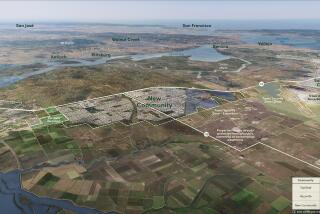Green Plan for Mexico Square Taking Root
- Share via
MEXICO CITY — To Mexico’s conquerors, dictators and revolutionaries, the capital’s majestic central plaza, the Zocalo, was the symbol of the country’s political and social life, humming with parades, hawkers and Sunday strollers.
To Mexico’s newly minted democrats, it is something else: an eyesore.
Now, the capital’s first elected government, led by its mayor, opposition hero Cuauhtemoc Cardenas, is proposing to transform the 96,000-square-yard site, which is as symbolic of this city as Red Square is of Moscow.
The plan would bring flowers, trees and perhaps fountains to the vast, concrete plaza flanked by the Spanish-colonial National Palace and cathedral.
But this is no mere landscaping job. In a country where symbols speak louder than words, the left-wing city government elected last year is grabbing control of an icon.
The Zocalo was “the living room of federal power,” said Jorge Legorreta, Cardenas’ delegate in the city center. “The president was always the man who ruled in this house,” even appointing the Mexico City mayor, he noted.
“But since 1997, he can’t be the exclusive boss of the living room. Now we have an elected government. This gentleman [Cardenas] has to decide how he wants the living room too.”
The long-ruling Institutional Revolutionary Party, or PRI, is irked by the plan, which it criticizes as a waste of money.
“Trees in the Zocalo? It’s like putting trees in San Marco Square in Venice, or in the Kremlin square, or in the Plaza de Espana in Madrid, or in St. Peter’s Square in Rome,” Manuel Aguilera, the PRI leader in the capital, fumed in a recent statement. “We don’t understand this idea about what constitutes a great public plaza.”
Still, the city government is moving forward. Backed by a public plebiscite and opinion polls that have found strong support for the “greening” of the Zocalo, it plans to announce a competition this month to find an architect.
The Zocalo has been the political center of Mexico since Aztec times. From the Spanish conquistadors onward, governments have put their own stamp on the square, some planting gardens, others erecting statues.
These days, the Zocalo continues to serve as a litmus test of power as groups ranging from the PRI to the left-wing Zapatista rebels show their strength by filling it for demonstrations. The Zocalo is also the site of the country’s most important celebration: Each year, 200,000 merrymakers jam the square on Sept. 15, the eve of Mexico’s independence from Spain.
But political demonstrators aren’t the only ones using the Zocalo. Tourists, Indian dancers in feathered headdresses and vendors hawking everything from Che Guevara T-shirts to fried pork rind mill around.
Alejandro Encinas, the city’s environment secretary, said the government wants to transform the Zocalo from a giant “cement tortilla” to a square reflecting the beauty of nature in a city ravaged by pollution and overdevelopment.
The proposal also reflects political change, he said. The Zocalo was paved in the early 1960s, when Mexico’s one-party authoritarian system was at its peak, he said.
“It was built so peasants could pass by the feet of the presidential balcony” in pro-government demonstrations, he said. “This is linked to authoritarian regimes. What are the great plazas of the world like the Zocalo? Red Square in Moscow and [Beijing’s] Tiananmen Square.”
“These were cult spaces for men in power,” Encinas said. “We want to restore the public spaces for citizens.”
But even a government made up of politicians who long fought for democracy while in the opposition isn’t above suspicion. Some critics have asked whether the landscaping is really aimed at discouraging demonstrations.
In response, the government has said it will seek a design that allows space for protesters--possibly including portable plants.
More to Read
Sign up for Essential California
The most important California stories and recommendations in your inbox every morning.
You may occasionally receive promotional content from the Los Angeles Times.










